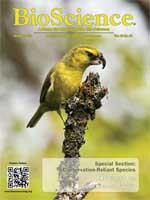When Elena Bray-Speth, assistant professor of biology at Saint Louis University, presented her case study on the evolution of fur color in mice, little did she know that someone in the audience had developed a case on the very same topic. That person was Jim Smith, principal investigator (PI) of Evo-Ed ( http://lbc.msu.edu/evo-ed), a National Science Foundation (NSF)-funded project that currently houses four evolutionbased case studies. “Elena and I met just after her session and I showed her our cases,” said Smith, who is a professor in the Lyman Briggs College and the Department of Entomology at Michigan State University.
The connection between Bray-Speth and Smith was made possible by the Introductory Biology Project (IBP; http:// ibp.ou.edu) during a conference held in late June at the American Association for the Advancement of Science in Washington, DC. Gordon Uno, PI of the IBP at the University of Oklahoma, organized the conference, which is one of many meetings he has hosted on the introductory biology experience. The IBP was the first Research Coordination Network for Undergraduate Biology Education (RCN—UBE) funded by the NSF in 2009. Its goal is to foster networking opportunities and new collaborations between those creating, implementing, or evaluating best practices in introductory biology teaching and learning.
The IBP summer conference brought together over 150 individuals focused on this goal, including graduate students and postdoctoral scholars, textbook publishers, representatives from scientific societies and education associations, science faculty with education specialties, members of the Biology Directors Consortium, two-year and four-year college and university faculty, and program officers from funding agencies.
For Bray-Speth and Smith, the conference sparked what they expect will be an ongoing collaboration. “Elena suggested the development of some online interactive activities that would bolster the case and help students with the content,” said Smith. The two plan on working together in the near future to enhance their case studies.
Others also found the gathering productive. “This conference was much more interactive than those I've experienced previously,” said Anna Hiatt, PhD candidate at Oklahoma State University. This was one of the first times at a conference that she felt as a graduate student that she was contributing in a major way. The conference connected Hiatt with others in her research area. Kathy Williams, at San Diego State University and PI of another RCN—UBE, called BioHUB, led a workshop for those developing, testing, or using conceptual assessments in biology. Many participants were interested in formalizing additional collaborations and met over breakfast the following morning to discuss professional development. After hearing the group say that they wanted to incorporate training for graduate students, Hiatt shared her needs and experiences and those of her peers. She felt comfortable doing so because Uno made it clear during the opening session that the voices of students and postdocs were welcome throughout the conference.
Another set of voices critical to include in conversations about the introductory biology experience are those of two-year faculty members. Twentyfive were present at the IBP conference, including Craig Longtine, of North Hennepin Community College, who gave a presentation on improving student engagement at two-year colleges through research experiences. Ellis Bell, of the University of Richmond, approached him afterward, because he shares a similar goal at his primarily undergraduate institution. They are now planning to develop a research-oriented community, said Bell. “Our thought was to expand on the growing level of undergraduate research at two-year colleges...through two-year-four-year collaborations that would support two-year college faculty in conducting authentic research with their students,” explained Longtine.
From the very start of his project, Uno envisioned scientific societies playing a key role in transforming the undergraduate introductory biology experience. The IBP conference provided two opportunities for participants to discuss the role of scientific societies. The conversations revealed that many scientific societies do not focus on specifically providing resources and programs aimed at introductory-course instructors. However, education associations such as the Association for Biology Laboratory Educators and the National Association of Biology Teachers do provide such resources. All those present at the IBP conference agreed that increased communication between these two types of organizations is essential. The group identified ways to address common challenges, such as drafting a statement about the importance of the introductory course for societies to endorse.
Approximately 300 people have participated in IBP meetings since the project started, including many who have attended multiple meetings. The work of the IBP will continue for another two years, bringing people focused on the introductory biology experience together to encourage more formal collaborations. “I am very pleased with the progress of the project,” said Uno. “We have been successful at bringing together different groups of people who might not have met otherwise, to discuss biology education reform and how we move forward together.”





